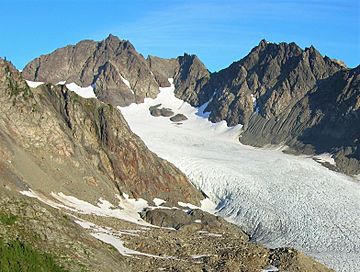Aries (mountain) facts for kids
Quick facts for kids Aries |
|
|---|---|

Aries (upper left) and Humes Glacier, from ESE
|
|
| Highest point | |
| Elevation | 6,533 ft (1,991 m) |
| Prominence | 373 ft (114 m) |
| Isolation | 0.61 mi (0.98 km) |
| Parent peak | Circe (6,847 ft) |
| Geography | |
| Location | Olympic National Park Jefferson County, Washington, US |
| Parent range | Olympic Mountains |
| Topo map | USGS Mount Olympus |
| Geology | |
| Age of rock | Eocene |
| Climbing | |
| Easiest route | class 3 scrambling via NW side |
Aries is a mountain peak in Washington state. It stands about 6,533 feet (1,991 meters) tall. You can find it inside Olympic National Park in Jefferson County. Its neighbors include the much taller Mount Olympus and Mount Mathias.
Aries sits between two large ice formations, the Hoh Glacier and the Humes Glacier. It is also just northeast of Blizzard Pass. Water from the mountain flows into the headwaters of the Queets River and Hoh River.
Two scientists, Richard Hubley and Edward LaChapelle, named this mountain in 1955. They were preparing for a big science event called the International Geophysical Year. They chose the name Aries (like the constellation) to fit the Greek and Roman mythology theme around Mount Olympus.
Mountain Weather
Aries is located in a "marine west coast" climate zone. This means it gets a lot of moisture from the Pacific Ocean. Most weather systems travel northeast towards the Olympic Mountains.
When these weather systems approach the mountains, the tall peaks force the air upwards. This causes the air to cool and drop its moisture as rain or snow. This process is called orographic lift. Because of this, the Olympic Mountains get a lot of rain and snow, especially in winter.
During winter, the weather is usually cloudy. But in summer, high-pressure systems over the Pacific Ocean often bring clear skies. The months from July to September usually offer the best weather. This is a good time to visit or climb Aries.
How the Mountains Formed
The Olympic Mountains are made of different kinds of rock. These include sandstone, turbidite (rock formed from underwater landslides), and basalt (a type of volcanic rock). These rocks were formed during the Eocene epoch, a long time ago.
The mountains got their shape during the Pleistocene era, also known as the Ice Age. During this time, large glaciers moved across the land many times. These glaciers carved out valleys and shaped the peaks we see today.



